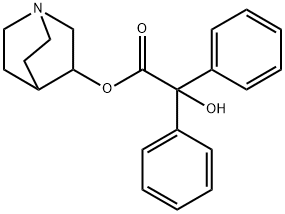3-Quinuclidinyl benzilate
|
|
3-Quinuclidinyl benzilate Eigenschaften
- Schmelzpunkt:
- 164.5°C
- Siedepunkt:
- 473.72°C (rough estimate)
- Dichte
- 1.1644 (rough estimate)
- Brechungsindex
- 1.5614 (estimate)
- storage temp.
- 2-8°C
- L?slichkeit
- chloroform: but decomposes within 24 hrssoluble
- pka
- 11.28±0.29(Predicted)
- Aggregatzustand
- powder
- Farbe
- white
- CAS Datenbank
- 6581-06-2
- NIST chemische Informationen
- 3-Quinuclidinyl benzilate(6581-06-2)
- EPA chemische Informationen
- Benzeneacetic acid, .alpha.-hydroxy-.alpha.-phenyl-, 1-azabicyclo[2.2.2]oct-3-yl ester (6581-06-2)
Sicherheit
- Risiko- und Sicherheitserkl?rung
- Gefahreninformationscode (GHS)
| Kennzeichnung gef?hrlicher | Xn,T+ | ||
|---|---|---|---|
| R-S?tze: | 22-26 | ||
| S-S?tze: | 28-36/37-45 | ||
| WGK Germany | 3 | ||
| RTECS-Nr. | DD4638000 | ||
| HS Code | 29333910 | ||
| Giftige Stoffe Daten | 6581-06-2(Hazardous Substances Data) | ||
| Toxizit?t | LD50 intraperitoneal in mouse: 103mg/kg |
| Bildanzeige (GHS) |

|
||||||||||||||
|---|---|---|---|---|---|---|---|---|---|---|---|---|---|---|---|
| Alarmwort | Achtung | ||||||||||||||
| Gefahrenhinweise |
|
||||||||||||||
| Sicherheit |
|
3-Quinuclidinyl benzilate Chemische Eigenschaften,Einsatz,Produktion Methoden
R-S?tze Betriebsanweisung:
R22:Gesundheitssch?dlich beim Verschlucken.Beschreibung
The 3-quinuclidinyl benzilate (3-QNB) was first discovered by Hoffmann-La Roche in 1951 during research investigation that involved development of antispasmodic agents, resembling atropine, for treating gastrointestinal conditions. Soon after, the US Army investigated 3-QNB under the name of EA2277 agent and was standardized for use in chemical munitions in 1961 under the name agent of BZ. The United States declared complete destruction of its stockpile of BZ by 1989. Moreover, Agent 15 is speculated either to be identical to BZ or a closely related derivative, and has similar physicochemical properties as BZ. In 1998, Agent 15 was speculated to be stockpiled by Iraq but later on intelligence reports did not find any conclusive evidence for such claim1. The BZ is a glycolate anticholinergic chemical related to atropine, scopolamine, and, hyoscyamine. It is odorless, nonirritating, and is stable in most solvents. It has a half-life of 3–4 weeks in moist air and is extremely persistent in soil, water, and most surfaces. BZ has a slow onset and a long duration-of-action. The rate of BZ action climaxed after 9.5 h of exposure and the duration-of-action could last up to 96 h. Moreover, most of the causalities of BZ exposure will require physical restraint and continuous monitoring to prevent self-injury and paranoia symptoms during recovery2. Recent speculation about the usage of Agent 15 in Syrian civil war had been reported but no confirmation findings had been established3.Chemische Eigenschaften
Colourless solidVerwenden
3-quinuclidinyl benzilate(BZ) is a nonlethal chemical warfare agent that following a delayed onset is incapacitating and causes severe hallucinations. US Army intended to use BZ in critical point situations such as special operation, incapacitating adversaries during raid, and overcoming fortified field positions. Medically, BZ is used as a muscarinic receptor antagonist.Allgemeine Beschreibung
Colorless liquid, odorless to fruity.Environmental Fate
BZ acts by blocking the action of acetylcholine on the central and peripheral nervous systems. It is a tertiary amine and crosses the blood–brain barrier. BZ on acute exposure increases both heart and respiratory rates, dilates the pupils, and causes paralysis of the eye muscles necessary for near focusing. It also causes dry mouth and skin, elevates body temperature, impairs coordination, and causes flushing of the skin, hallucinations, stupor, forgetfulness, and confusion.Within 15 min to 4 h following exposure, the principal effects are dizziness, involuntary muscle movements, near vision difficulty, and total incapacitation. From 6 to 10 h after exposure, the effects are psychotropic and full recovery is expected after 4 days.The peripheral nervous system effects are considered as understimulation of the end organs. This decreased stimulation of eccrine and apocrine sweat glands in the skin results in dry skin and a dry mouth, and is considered ‘dry as a bone.’ The reduction in the ability to dispel heat by evaporative cooling decreases sweating, and the compensatory cutaneous vasodilation causes the skin to become warm or ‘hot as a hare’ and ‘red as a beet.’ This is similar to the atropine flush. The decreased heat loss also results in an increased core temperature.
3-Quinuclidinyl benzilate Upstream-Materialien And Downstream Produkte
Upstream-Materialien
Downstream Produkte
6581-06-2()Verwandte Suche:
Ethylacetat
3,6-Bis[(4-chlor-2-phosphonophenyl)azo]-4,5-dihydroxynaphthalin-2,7-disulfonsure
Cyclandelat
Vinylacetat
Natriumacetat
3,4-Dihydro-2,5,7,8-tetramethyl-2-(4,8,12-trimethyltridecyl)-2H-benzopyran-6-ylacetat
Chinuclidin
Quinine sulfate dihydrate
Glatiramer acetate
Davercin
Ammoniumacetat
Chinindihydrochlorid
Chinuclidin-3-ol
Glykolsaeure
Clidiniumbromid
Benzilsure
ACETATE
- 1-Azabicyclo(2.2.2)octan-3-ol, benzilate
- 1-azabicyclo(2.2.2)octan-3-ol,benzilate
- 1-Azabicyclo[2.2.2]oct-3-yl hydroxy(diphenyl)acetate
- 3-(2,2-diphenyl-2-hydroxyethanoyloxy)-quinuclidine
- 3-Chinuclidylbenzilate
- 3-Hydroxyquinuclidine benzilate
- 3-Oxyquinuclidine benzilate
- 3-Quinuclidinol benzilate
- 3-Quinuclidinol, benzilate (ester)
- 3-quinuclidinolbenzilate
- 3-Quinuclidyl benzilate
- 3-quinuclidylbenzilate
- Benzeneacetic acid, a-hydroxy-alpha-phenyl-, 1-azabicyclo[2.2.2]oct-3-yl ester
- Benzeneacetic acid, alpha-hydroxy-alpha-phenyl-, 1-azabicyclo(2.2.2)oct-3-yl ester
- Benzilic acid, 3-quinuclidinyl ester
- RS(+/-)-QUINUCLIDINYL BENZILATE (+/-)-QN B
- Benzeneacetic acid, a-hydroxy-a-phenyl-, 1-azabicyclo[2.2.2]oct-3-yl ester
- beta-Quinuclidinyl benzilate
- 1-Azabicyclo[2.2.2]octan-8-yl 2-hydroxy-2,2-di(phenyl)acetate
- benzilicacid,3-quinuclidinylester
- b-Quinuclidinyl benzilate
- CS 4030
- cs4030
- EA 2277
- ea2277
- Ro 2-330
- RO 2-3308
- ro2-3308
- 3-QUINUCLIDINYL BENZILATE
- NSC 173698
- (±)-QNB, (±)-Quinuclidinyl α-hydroxydiphenylacetate
- 3-Quinuclidinol hydroxydiphenylacetate
- Benzilic acid quinuclidin-3-yl
- Benzilic acid quinuclidin-3-yl ester
- Diphenylhydroxyacetic acid 1-azabicyclo[2.2.2]octane-3-yl ester
- 3-QUINOCLIDINYLBENZILATE
- (±)-Quinuclidinyl α-hydroxydiphenylacetate
- HGMITUYOCPPQLE-UHFFFAOYSA-N
- Benzeneacetic acid, α-hydroxy-α-phenyl-, 1-azabicyclo[2.2.2]oct-3-yl ester
- Quinuclidin-3-yl 2-hydroxy-2,2-diphenylacetate
- BZ
- Clidinium Bromide Impurity 1
- 6581-06-2







